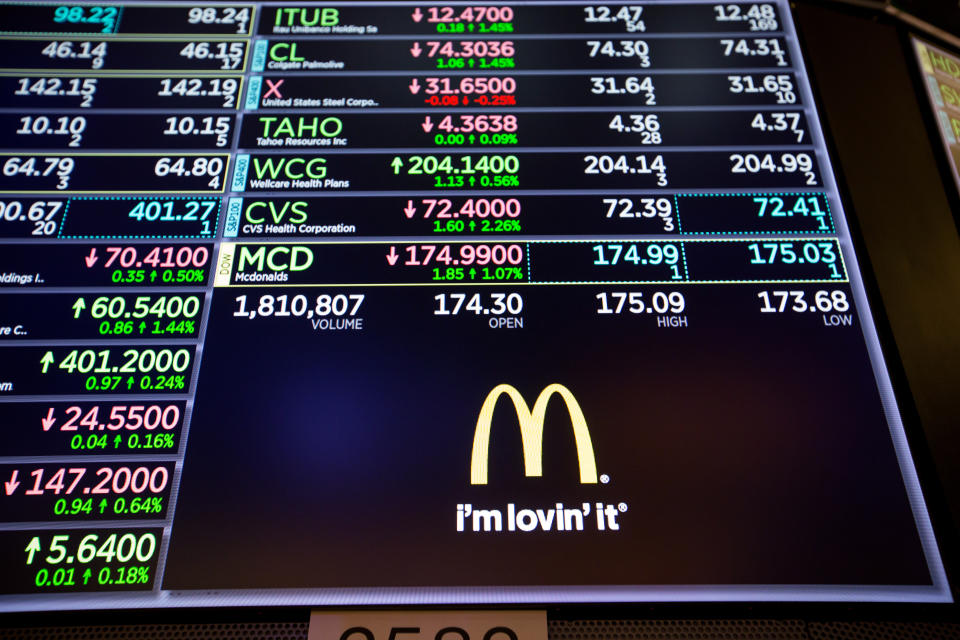Bonds are the greatest threat to stocks right now: trader
First-quarter earnings last week provided a much-needed counterbalance to the recent months-long move lower in equity prices. The results posted by large-cap technology companies like Amazon (AMZN), and Facebook (FB), in particular, offered significant relief to panic-struck investors.
Macroeconomic data released last week did, to a degree, allay fears of accelerating inflation and a near-term ratcheting up in interest rates as a result of a drop in the Q1 GDP relative to Q4 of 2017. The Chicago Fed National Activity Index for March was significantly slower than the prior month’s revised reading of .98. The Richmond Fed Manufacturing Index ticked into negative territory for April, coming in at – 0.3. March’s reading was 15. Durable goods orders for March were solidly positive at 2.6%, though weaker than February’s revised reading of 3.5%.
Consumer-centric data released last week was encouraging. The Conference Board’s Consumer Confidence Reading for April was 128.7, beating consensus at 126.1 and the prior month’s 127. The University of Michigan’s Consumer Outlook reading remained in-channel at 98.8 versus the previous month’s reading of 98. Significant and ongoing gains in employment across nearly every sector of the economy in conjunction with rising wages and recently enacted tax cuts are providing support to American consumers and their collective outlook.
Earnings a tailwind
Earnings season continues this week, following the busiest week of the quarter last week. Today’s highlights include Allergan plc (AGN), CNA Financial (CNA), Enterprise Products Partners L.P. (EPD), McDonald’s (MCD) and Vornado Realty Trust (VNO).

If the previous several weeks of earnings season are any indication, corporate results should continue to act as a buffer to any meaningful turn lower in equity markets.
This week’s economic calendar will be dominated by the FOMC Meeting and Announcement, the ADP Employment Report and Friday morning’s release of the Monthly Employment Report. According to Bloomberg consensus, April’s Employment Report is expected to reflect a gain of 190K jobs versus March’s unexpectedly weak 103K. The unemployment rate is expected to tick down to 4% from the current 4.1%. Additionally, consensus is calling for another gain in manufacturing to 19K.
Better-than-expected Q1 corporate results, indications of sustainable economic expansion and receding headlines focused on large-cap tech privacy concerns have all provided a degree of long sought-after stability in markets last week. However, the principal threat to equity markets remains rising interest rates. Though the 10-year (^TNX) closed out last week below 3%, it is clear that the trend is higher. As a result, fear is that the economic expansion has achieved escape velocity, and the Fed may move more aggressively on rates than warranted. Additionally, investors have taken a cautious tone on risk as a result of the tightening spread between the 2-year and 10-year, in other words, flattening. We have not witnessed a tighter spread between those two maturities since the onset of the Great Recession. This week’s FOMC meeting and announcement will be pivotal.
Commentary by Sam Stovall, CFRA chief investment strategist
U.S. equity markets have been battered by a multitude of exaggerated fears: Earnings are peaking, inflation is ready to explode, interest rates are preparing to go parabolic, tech is taking us through a 2000-like tanking, the simmering trade war will boil over into a global recession, and this stock market correction will morph into a new bear market. Even though this correction will likely need to do more “backing and filling” before concluding, we don’t think investors should begin composing this bull market’s eulogy. We still project the S&P 500 to record a mid-single digit price gain by year-end, while enduring elevated volatility along the way. The angle of ascent for the S&P 500’s year-over-year EPS growth is expected to peak in the third quarter of this year at 21.7%, but future-quarter growth is estimated to remain at or near 10% through Q4 2019. In addition, we see the 10-year yield averaging below 3.15% through mid-2019.

